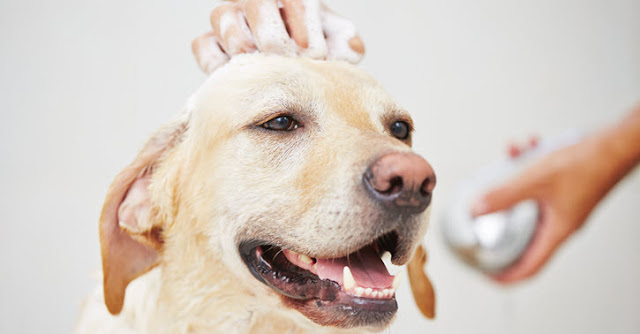While you have the right to take your assistance dog into public places and business establishments, it comes with the responsibility of keeping your dog presentable, clean, and odor-free. This, combined with extra physical exertion and frequent forays into the world, often necessitates bathing service dogs more often than pets.
Exactly how often depends on your dog, her coat, circumstances of her daily life and work, and other factors. Typically, assistance dogs should be bathed anywhere from once per week to once every few months, but get personalized advice from your veterinarian or professional groomer.
Also, ask for shampoo and conditioner recommendations. Only use products formulated for dogs, and choose mild, moisturizing products to prevent drying out or irritating your dog’s skin.
Bathing Options for Your Service Dog
If you’re unable to bathe your dog, a professional groomer can do so for you. If you choose to do it yourself, you have a few options. Many groomers, kennels, pet spas, and pet daycare facilities have self-service dog washes, providing the setup and supplies while you do the bathing.
The bathtub works if your dog fits in it and isn’t likely to cause water to splash out over the sides, and some dogs don’t mind a shower stall.
When it’s not cold out, a kiddie pool or hose are options for cooperative animals. Special tubs designed for dog baths are commercially available, and they can make things much easier (especially if your dog needs restraint, as most have clips for leash attachment).
Acclimate Your Assistance Dog to Bathing
You may very well partner with a service dog who’s already used to bathing and cooperative. However, if your dog is young or not too enthusiastic, take some time to get her used to the idea of bathing.
Start by putting her into the dry bathtub once or twice per day, then build up to putting in a little water and getting her increasingly wet over the course of a few days. Lure her in with a treat, but refrain from calling her, as you don’t want to teach her that your call leads to unpleasant experiences. Reward the sessions with praise and treats.
Always immediately follow baths with positive reinforcement and your assistance dog will learn to like them. This can mean treats, a favorite game, dinner, a new chew toy, or something else your dog loves to get.
Giving the Bath
Have everything you need on hand so you don’t have to leave your service dog unattended during the bath; at minimum, this includes a vessel for pouring water, dog shampoo and conditioner, a washcloth, and towels for drying.
Place a large mat or thick towel down to keep your dog from slipping and sliding around to help her feel secure and prevent injuries. Also, position a mesh sponge over the drain to catch shed hair and prevent clogs. Brush out tangles and mats prior to bathing.
If you’re in the bathroom, close the door in case your dog decides the bath is over before you do. Thoroughly wet your assistance dog’s coat with a cup, pitcher, or small bucket, though some dogs accept a shower attachment. Lather your dog’s coat with shampoo as per the instructions on the bottle, but just wipe her head and face with a wet washcloth to avoid getting shampoo in her ears, eyes, or mouth. Rinse her well, using your fingers to move hair around and get all the product out of her fur. Then repeat the process with conditioner, following the package instructions.
Rinsing can take a while if your dog has a thick coat, but it’s important to be thorough, as leaving shampoo or conditioner on can cause irritation.
After Bathing Your Service Dog
Regular towels generally suffice for drying after the bath, and it’s helpful if you toss them in the dryer for a little while before use. Pet stores sell extra-absorbent towels that work even better than standard towels, though. Some people like to blow dry their dogs, but this requires getting your dog used to the sound and sensation. Only use a low-heat setting, and don’t blow the air into your dog’s ears or face.
Many dogs rub themselves on the ground or furniture after a bath, so keeping yours confined to the kitchen or another area without lots of dirt on the ground or leather couches is prudent.
Don’t forget the post-bath treats. Also, medium- and long-haired dogs should be brushed or combed after a bath.

